Hola una vez más.
Hi again.
En el siguiente enlace podéis ver nuestros próximos viajes fotográficos y de observación de aves y mamíferos nacionales y al extranjero. Espero que os gusten y os animéis a venir conmigo. Una experiencia que nunca olvidareis.
Hi again.
En el siguiente enlace podéis ver nuestros próximos viajes fotográficos y de observación de aves y mamíferos nacionales y al extranjero. Espero que os gusten y os animéis a venir conmigo. Una experiencia que nunca olvidareis.
In the following link you can see our next national and foreign Birds and Mammals photographic and observation trips. I hope you like them and I encourage you to come with me. An experience that you will not forget.
Esta vez os muestro alguna de las aves que hemos podido ver en un viaje programado de cinco días de duración durante el puente del 1 de mayo pues, en Madrid, el día 2 también es festivo.
This time I show you some Birds that we have been able to see on a five-day scheduled trip during May 1 to 5 because in Madrid day May first and second are holidays.
Al ser un viaje con varios destinos distintos, he separado el relato en cada día de viaje en lugar de aglutinar fotos de las especies vistas pues de esa manera se puede ver que fue lo que pudimos ver y fotografiar en cada uno de ellos.
Being a trip with several different destinations, I have divided the post on each day of travel instead of agglutinating photos through species watched because then you can see what we saw and photographed in each of them.
Como veréis a continuación, empezamos por Zamora y León para poder ver el celo de la avutardas comunes (Otis
tarda) y luego las Grajas (Corvus frugilegus). Al día siguiente fuimos por Asturias a Zeluán, Cabo Peñas y Gijón. El tercer día volvimos a repetir Gijón y por la tarde la Bahía de Santander. El cuarto día hicimos Santoña y el quinto Picos de Europa. Un viaje muy movido y que vimos todas las especies previstas y también alguna otra no prevista.
As you will see below, we start by Zamora and León to see the display of the Great Bustards and then Rooks. Next day we went through Asturias to Zeluán, Cabo Peñas and Gijón. Third day we repeated Gijón and in the afternoon the Bay of Santander. On the fourth day we made Santoña and the fifth Picos de Europa. A very busy trip in which we saw all the species planned and also some other not expected.
Sin lugar a dudas la especie que más me gusto poder localizar y fotografiar fueron los treparriscos (Tichodroma
muraria) pues en solo una mañana es difícil poder observarlos pero en este caso tuvimos suerte y sobre todo buena vista.
Undoubtedly the species that I liked the most to locate and photograph were the Wallcreepers because in just one morning it is difficult to observe them but in this case we were lucky and especially good spotted.
Día 1 de mayo, Zamora y León:
Day May 1st, Zamora and Leon:
Como hacía mucho calor la evaporación de terreno era muy fuerte y no se podían hacer buenas fotos. Normalmente para fotografiar las avutardas comunes (Otis tarda) hay que ir temprano o la mañana o, mejor aún, al atardecer cuando la evaporación es mucho menor. No obstante vimos varias ruedas.
Since it was very hot evaporation of the fields was very strong and you could not make good pictures. Normally to photograph Great Bustards you have to be early or in the morning or, much better, at sunset when the evaporation is less. However we saw several displays.
Vimos muchos machos.
We saw many males.
Os he subido este video para que veáis lo difícil que es sacar algo decente con la evaporación del terreno. Pido disculpas por la baja calidad del mismo.
I have uploaded this video so you can see how difficult it is to get something decent with the evaporation of the land. I apologize for its low quality.
Cuando los clientes estuvieron satisfechos con las observaciones de las avutardas comunes ((Otis tarda) decidí ir a otros lugares de Villafáfila para ver otras especies de aves. En la foto un chorlitejo chico (Charadrius
dubius)
When clients were satisfied with the observations of the Great Bustards I decided to go to other places in Villafáfila in search of other species of Birds. In the photo a Little
Ringed Plover.
Macho de lavandera boyera (Motacilla
flava).
Yellow
Wagtail male.
Archibebe común (Tringa
totanus).
Common
Redshank.
Archibebe claro (Tringa
nebularia).
Greenshank.
Macho de cigüeñuela común (Himantopus
himantopus).
Male of Black-winged
Stilt.
Milano negro (Milvus
migrans).
Black
Kite.
Abejaruco europeo (Merops
apiaster).
European
Bee-eater.
Te pillé.
I catch you.
Macho de cernícalo primilla (Falco naumanni).
Male Lesser
Kestrel.
Hembra.
Female.
Macho de gorrión común (Passer
domesticus).
House
Sparrow male.
Gorrión chillón (Petronia
petronia).
Rock Sparrow.
Águila calzada (Aquila
pennata) fase oscura.
Dark phase Booted
Eagle.
Y después de comer fuimos al centro de interpretación del Parque pues nos habían dicho que podíamos ver algún correlimos de Temminck (Calidris
temminckii). Lo primero que hicimos fue ir al recinto en el que tienen varias avutardas comunes (Otis tarda). En la foto una hembra.
And after lunch we went to the interpretation Center of the Park because they had told us that we could see some Temminck’s
Stint. The first thing we did was go to the place where they have several common bustards. In the photo a female.
Impresiona ver estas aves tan grandes cerca de ti.
It is awesome to see these big Birds close to you.
Y sobretodo el macho.
And above all the male.
Nunca había visto el iris de esta especie tan bien. En algunas ocasiones se ponían debajo del observatorio del recinto. A menos de un metro de nosotros. fijaos en la siguiente foto que la saqué con el teléfono móvil.
I had never seen the iris of this species so well. Sometimes they were placed under the observatory of the enclosure. Less than a meter from us. Look at the next photo that I took with the my cell phone.
Como era ya primeros de mayo el macho tenía las plumas en mal estado.
As it was already early May male had its feathers in poor condition.
Aunque sigue siendo una preciosidad.
Although it is still gorgeous.
Vimos al correlimos de Temminck (Calidris temminckii) aunque siempre a contraluz.
We saw Temminck’s
Stint although always against light.
Había 11 fumareles comunes (Chlidonias
niger).
There were 11 Black
Terns.
Y muchos ánsares comunes (Anser
anser) y entre ellos algunas parejas estaban con crías.
And many Greylag
Geese and among them some couples were with Goslings.
Avocetas comunes (Recurvirostra
avosetta).
Pied Avocet.
Macho de cigüeñuela común (Himantopus
himantopus).
Black-winged
Stilt.
De camino a Asturias hicimos una parada en una colonia de cría de grajas (Corvus frugilegus).
On the way to Asturias, we made a stop at a Rook breeding colony.
En España solo existen núcleos reproductores en la provincia de León y durante el invierno algunas aves del noreste europeo llegan hasta España principalmente en el Valle del Ebro.
In Spain there are only breeding colonies in the province of León and during winter some Birds of northeastern Europe arrive to Spain mainly in the Ebro Valley.
Un vídeo de esta escasa ave en España.
A video of this sparse bird in Spain.
2 de Mayo: Zeluán, Cabo de Peñas y Gijón:
May 2: Zeluán, Cabo de Peñas and Gijón:
La mañana comenzó no muy bien pues estuvo lloviendo durante un buen rato. Sobre las 10:00 paró de llover y luego se quedço un dia estupendo.
The morning started not very well because it was raining for some time. About 10:00 it stopped raining and then we had a sunny day.
Pocas veces había visto bandos tan grandes de zarapitos trinadores (Numenius
phaeopus).
I had rarely seen such large flocks of Whimbrels.
Llegaban y se iban a los campos circundantes.
They arrived and went to the surrounding fields.
También había algunos chorlitos grises (Pluvialis
squatarola).
There were also some Gray Plovers.
Agujas colipintas (Limosa
lapponica).
Bar-tailed
Godwit.
Correlimos comunes (Calidris
alpina).
Dunlins.
Correlimos tridáctilos (Calidris
alba).
Sanderlings.
Las dos especies antes mencionadas.
The two species mentioned above.
Y chorlitejos grandes (Charadrius
hiaticula).
And Great
Ringed Plovers.
Garceta común (Egretta
garzetta).
Little
Egret.
Fotografía de una de las playas que visitamos.
Photograph of one of the beaches we visited.
Y fijaos el día que se quedó cuando llegamos al Cabo de Peñas. Un auténtico regalo.
And look at the day we had when we arrived at Cabo de Peñas. A great present.
Además estaba todo lleno de flores.
In addition it was full of flowers.
Preciosas vistas del Cabo.
Beautiful Cape views.
Y de sus alrededores.
And its surroundings.
Volviendo al tema que nos ocupa, una macho de tarabilla europea (Saxicola rubicola) que estaba muy atareada llevando comida a sus pollos.
Returning to our matter, a male Common
Stonechat was very busy bringing food to their chicks.
Y lo mismo hacía su hembra.
And so did his female.
Solo vimos estos dos alcatraces atlánticos (Morus
bassanus) y no todos, pues la mayoría estaba comiéndose unas fabes con langosta en el restaurante del Cabo cuando pasaron.
We only saw these two Northern
Gannets. And not all people, since most of the clients were eating lobster with beans at the Cabo restaurant when they passed by.
Un macho de colirrojo tizón (Phoenicurus
ochruros) muy confiado.
A tame male Black
Redstart.
Son preciosos.
They are beautiful.
Y esta parecía ser su hembra que no me quiso mirar.
And this seemed to be his female who did not want to look at me.
También vimos varios pardillos comunes (Carduelis
cannabina) pero como siempre muy desconfiados. En la foto un macho.
We also saw several Common Linnets but as always very distrustful. In the photo a male.
Y tres halcones peregrinos (Falco
peregrinus).
And three Peregrine
Falcons.
Casi se me olvida comentaros que también había muchas gaviotas patiamarillas (Larus
michahellis).
I almost forgot to mention that there were also many Yellow-legged Gulls.
Bisbita pratense (Anthus
pratensis).
Meadow
Pipit.
Y varios faisanes vulgares (Phasianus
colchicus).
And several Common Pheasants.
Me parece que este macho se ha equivocado de sexo pues está haciendo la rueda a otro macho.
It seems to me that this male has mistaken sex because he is displaying to another male.
Macho de collalba gris (Oenanthe
oenanthe).
Northern
Wheatear male.
Macho de lavandera boyera (Motacilla flava).
Male Yellow
Wagtail.
Precioso.
Beautiful.
Y como llegamos pronto a Gijón, decidimos darnos una vuelta a ver que veíamos. EN la foto una corneja negra (Corvus
corone).
And as we arrived early to Gijón, we decided to take a tour to see what we can watch. In the photo a Carrion
Crow.
Archibebe claro (Tringa
nebularia).
Greenshank.
Archibebe común (Tringa
totanus).
Common
Redshank.
Y un ave inesperada, una gaviota de Delaware (Larus delawarensis).
And an unexpected bird, a Ring-billed gull.
Esta gaviota es un raro visitante de América del Norte y Canadá que es donde se reproduce.
This gull is a rare visitor from North America and Canada which is where it reproduces.
Y ya pudimos ver los primeros correlimos oscuros (Calidris
maritima) que era una de las atracciones de este viaje.
And we could already see the first Purple Sandpiper which was one of the attractions of this trip.
También había un correlimos gordo (Calidris
canutus) en plumaje nupcial.
There was also a Red Knot in breeding plumage.
Estaba precioso.
It was lovely.
Gaviota reidora (Chroicocephalus
ridibundus).
Black-headed
Gull.
3 de Mayo: Gijón, Bahía de Santander y Santoña.
May 3: Gijón, Santander Bay and Santoña.
Aunque ya habíamos ido por Gijón decidimos volver pues las previsiones meteorológicas eran buenas y poder ver las especies mejor. En la foto la gaviota de Delaware (Larus delawarensis)que ya habíamos visto el día anterior.
Although we had already gone through Gijón, we decided to return because the weather forecast was good and we could see the species better. In the photo the Ring-billed gull that we had seen the previous day.
Archibebe común (Tringa
totanus).
Common
Redshank.
Chorlitejo grande (Charadrius
hiaticula).
Great
Ringed Plover.
Archibebe claro (Tringa
nebularia).
Greenshank.
Chorlito gris (Pluvialis
squatarola).
Grey
Plover.
Agujas colipintas (Limosa
lapponica).
Bar-tailed
Godwit.
Dos de ellas estaban muy bonitas ya.
Two of them were very beautiful already.
Garceta común (Egretta
garzetta).
Little
Egret.
Vuelvepiedras común (Arenaria
interpres).
Turnstone.
El correlimos gordo (Calidris
canutus) también visto el día anterior.
The Red Knot also seen the day before.
Y correlimos oscuros (Calidris
maritima).
And Purple Sandpiper.
Correlimos tridáctilos (Calidris
alba).
Sanderlings.
Y en esta foto varios de los que ya os he enseñado en las fotos precedentes de los que no digo sus nombres a ver si sois capaces de reconocer las distintas especies. Una pista, hay solo 4 especies.
And in this photo several of those that I have already shown you in the previous photos of which I do not say their names to see if you are able to recognize the different species. A clue, there are only 4 species.
Después de comer nos fuimos a la Bahía de Santander y vimos charranes comunes (Sterna
hirundo).
After lunch we went to the Bay of Santander and saw Common Terns.
Somormujo Lavanco (Podiceps
cristatus).
Great
Crested Grebe.
Y unos gladiolos silvestres que llamaron nuestra atención. Preciosos.
And some wild gladioli that caught our eye. Beautiful.
Como os decía a todos los participantes les gustaron estas flores.
As I said all the participants liked these flowers.
Este ibis sagrado (Threskiornis aethiopicus) fue la primer ave que vimos al llegar a Santoña.
This Sacred Ibis was the first Bird we saw when arriving in Santoña.
En españa es un ave ocasional. Es oriunda, principalmente, de África Subsahariana y en el oeste de Madagascar. Hay una población en la parte Atlántica de Francia de cierta importancia que se establecieron ya hace tiempo y que proviene de aves escapadas de colecciones privadas. Posiblemente, esta sea una de estas últimas.
In Spain it is an occasional Bird. It is native, mainly, of sub-Saharan Africa and in the west of Madagascar. There is a population in the Atlantic part of France of some importance that was established long ago and that comes from Birds escaped from private collections. Possibly, this is one of the latter.
Aun quedaba al menos un colimbo grande (Gavia immer) que aun no había realizado la migración al Norte para pasar el verano.
There was still at least a Great
Northern Diver that had not yet made the migration to the North to spend the summer.
Y al comenzar las garcillas (Bubulcus
ibis) bueyeras a ocupar sus lugares para pasar la noche nosotros decidimos hacer lo mismo.
And when the Cattle Egrets started to go to their places to spend the night we decided to do the same.
4 de Mayo: Santoña, Fuente Dé.
May 4: Santoña, Fuente Dé.
Comenzamos la mañana visitando el puerto de Santoña. En la foto un cormorán moñudo (Phalacrocorax
aristotelis).
We start the morning visiting the Port of Santoña. In the photo an European Shag.
Garza real (Ardea
cinerea).
Grey
Heron.
Vimos varios bandos de correlimos comunes (Calidris
alpina).
We saw several flocks of Dunlins.
Y en algunos iban también chorlitejos grandes (Charadrius
hiaticula).
And in some there were also Great
Ringed Plover.
Andarríos chico (Actitis
hypoleucos).
Common
Sandpiper.
Y fuimos a ver si podíamos encontrar a una de las fochas comunes (Fulica
atra) leucisticas que hay allí. Esta es la mas blanca. La que tiene más negro la vimos pero no pude sacarle una foto.
And we went to see if we could find one of the leucistic Common Coots that live there. This is the whitest The one that has more black we saw it but I could not take a picture of it.
Macho de porrón europeo (Aythya
ferina).
Male Common
Pochard.
Gavión atlántico (Larus marinus).
Great
black-backed Gull.
Águila calzada (Aquila
pennata) fase oscura.
Dark phase Booted
Eagle.
Espátulas comunes (Platalea
leucorodia).
Eurasian
Spoonbills.
Y el colimbo grande (Gavia immer) que debía ser el mismo de la tarde anterior.
And the Great
Northern Diver that should have been the same as the previous afternoon.
Garceta común (Egretta
garzetta).
Little
Egret.
Y muy cerca de donde estábamos vimos como pescaba un pez.
And very close to where we were we saw how it caught a fish.
Tórtola europea (Streptopelia
turtur).
European
Turtle Dove.
Combatiente (Philomachus
pugnax).
Ruff.
Milano negro (Milvus
migrans).
Black
Kite.
Zarapito trinador (Numenius
phaeopus).
Whimbrel.
Y en esta foto hay la especie precedente a la que se le habían añadido unos chorlitos grises (Pluvialis
squatarola). El primero por la izquierda y el cuarto por la derecha.
And in this photo there is the preceding species to which some Gray Plovers had been added. The first on the left and the fourth on the right.
Y en esta otra además de las dos especies anteriores hay un archibebe común (Tringa
totanus). El primero por la izquierda.
And in this other in addition to the two previous species there is a Common
Redshank. First one on the left.
Y otro archibebe común (Tringa totanus) para que os sea más fácil el haber distinguido el que hay en la foto de arriba.
And another Common Redshank to make it easier for you to distinguish the one in the photo above.
Ostreros euroasiáticos (Haematopus
ostralegus).
Eurasian
Oystercatchers.
Vimos juntos hasta nueve cisnes vulgares (Cygnus
olor).
We watched together up to nine Mute Swans.
Estos dos más cerca.
These two closer.
Y aunque muy lejanos pasaron volando tres cisnes negros (Cygnus atratus) que ya los habíamos visto en el mes de febrero en la marisma de Hinojedo. Os dejo un enlace por si los queréis ver en el blog que publiqué de Santoña: Birding Santoña
And although very distant three black swans flew by (Cygnus atratus) that we had already seen in the month of February in the marsh of Hinojedo. I leave a link if you want to see in the blog that I published: Birding Santoña
Cuando ya salíamos de viaje para Fuente Dé vimos al macho de eider común (Somateria
mollissima) que lleva ya algunos años por Santoña y que no migra. Aunque se le ve volar bien, algo debe tener que le impide migrar. Fijaos que las plumas del pecho están muy deterioradas.
When we were already on our trip to Fuente Dé, we saw the Common Eider male that has been in Santoña for some years and does not migrate. Although he flys well, something must have prevented him from migrating. Notice that the feathers on the chest are very damaged.
5 de Mayo: Picos de Europa.
May 5: Picos de Europa.
Mientras esperábamos a que se abriera el Cable y pudiéramos llegar al piso alpino, vimos a este macho de colirrojo real (Phoenicurus
phoenicurus) cantando.
While we were waiting for the Cable to be open and to be able to reach the alpine floor, we saw this male Common Redstart.
Nada más llegar a la cafetería del Cable, ya a más de 1.800 metros sobre el nivel del mar, vimos como un macho de roquero rojo (Monticola
saxatilis) echando de su territorio a unos acentores alpinos (Prunella
collaris).
As soon as we arrived at the Cable Cafeteria, at more than 1,800 meters above sea level, we saw a Rock Thrush chasing away Alpine Accentors from its territory.
Además de las aves que se pueden ver en este Parque Nacional, las vistas del Macizo Central de los Picos de Europa son extraordinarias.
In addition to the birds that can be seen in this National Park, the views of the Central Massif of the Picos de Europa are awesome.
Vimos bastantes collalbas grises (Oenanthe
oenanthe) pero todas muy esquivas. En la foto un macho.
We saw quite a few Northern
Wheatear but all very elusive. In the photo a male.
Todo lo contrario ocurre con las chovas piquigualdas (Pyrrhocorax
graculus).
Quite the opposite occurs with the Yellow-billed
Choughs.
Acuden a las personas en cuanto se sientan a comer.
They go to people as soon as you sit down to eat.
Da gusto tener aves tan cerca y sin tener miedo de las personas.
It's nice to have birds so close and without being afraid of people.
Son unas aves preciosas.
They are beautiful birds.
Incluso se las puede sacar fotos con el teléfono móvil cuando no dispones de una cámara fotográfica.
You can even take photos with your cellular phone when you do not have a camera.
Un inmaduro de águila real (Aquila
chrysaetos) sobrevoló nuestras cabezas.
An immature Golden Eagle flew over our heads.
Me lleve una grata sorpresa cuando pude ver a esta hembra de treparriscos (Tichodroma
muraria). Ya habíamos ido a donde los suelo ver por el verano en nuestra excursión para ver aves alpinas. Os dejo un enlace por si os apetece uniros que ya quedan pocas plazas:Picos de Europa, 5 al 7 de julio aves alpinas
I was pleasantly surprised when I saw this female treparriscos (Tichodroma muraria). We had already gone to where I usually see them during the summer on our excursion to see alpine birds. I leave a link if you want to join that there are few places left: Picos de Europa July 5 to 7 Alpine Birds
Y luego aparecio el macho.
And then the male appeared.
En ambos casos ya con plumaje nupcial aunque en el caso de la hembra no hay mucha diferencia con respecto al plumaje de invierno.
In both cases in breeding plumage although in the case of the female there is not much difference with respect to the winter plumage.
Estaba lleno de estas polillas Eurranthis plummistaria. En la foto un macho.Eran preciosas.
It was full of these moths called Crowned Moth . In the photo a male.They were beautiful.
Este fue el único bisbita alpino (Anthus
spinoletta) que vimos.
This was the only Water
Pipit we saw.
Y bastantes buitres leonados (Gyps
fulvus) aunque todos muy altos.
And many Griffon Vultures , although all very high.
También oimos un fuerte estruendo y cuando miramos en dirección de donde venía vimos que había sido un alud de nieve y rocas en donde habíamos estado por la mañana. Aunque no llegó al paseo en donde estábamos me imagino que de haber estado en ese mismo sitio el susto hubiese sido muy grande.
We also heard a loud noise and when we looked in the direction from which it came we saw that it had been an avalanche of snow and rocks where we had been in the morning. Although it did not get to the walk where we were, I imagine that if we had been in that same place the scare would have been tremendous.
Como era de esperar vimos acentores alpinos (Prunella
collaris) aunque los gorriones alpinos los vimos volando pero no pude sacarles ninguna foto. En la foto los primeros.
As expected we saw Alpine accentors and Snowfinches but only in fly and I could not get any pictures of them. In the photo the first ones.
Parece mentira que las chovas piquirrojas (Pyrrhocorax
pyrrhocorax) sean tan esquivas. No tiene el carácter afable de las piquigualdas.
It seems incredible that the Red-billed Choughs are so elusive. It does not have the friendly nature of the Yellow-billed
Choughs.
Y para terminar este blog y ya cuando estábamos regresando a Madrid hicimos un alto en el puerto de Piedrasluengas.
And to finish this blog and when we were returning to Madrid we made a stop at the Pass of Piedrasluengas.
Me extraño ver un buitre negro (Aegypius
monachus) tan alejado de sus lugares habituales de residencia aunque no es el primero que veo en la cornisa Cantábrica.
I was surprised to watch a Black Vulture so far from its usual places of residence, although it is not the first one I see on the Cantabrian mountain range.
Y con él estaban cicleando un grupo de buitres leonados (Gyps
fulvus).
And with it they were circling a group of Griffon Vultures.
Hasta pronto.
See you soon.













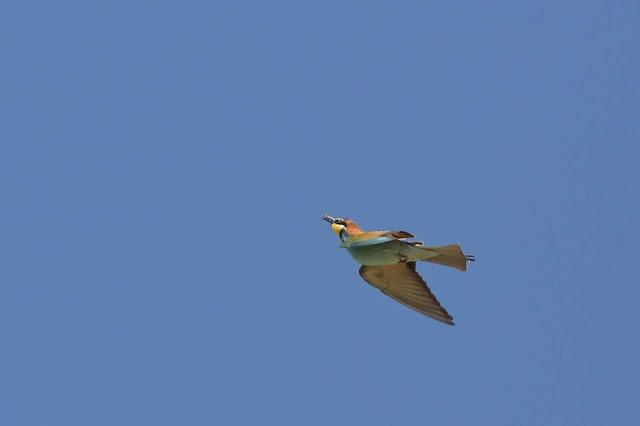






















































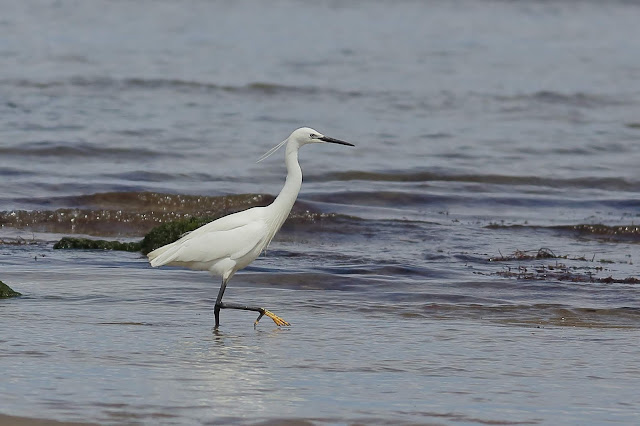


























































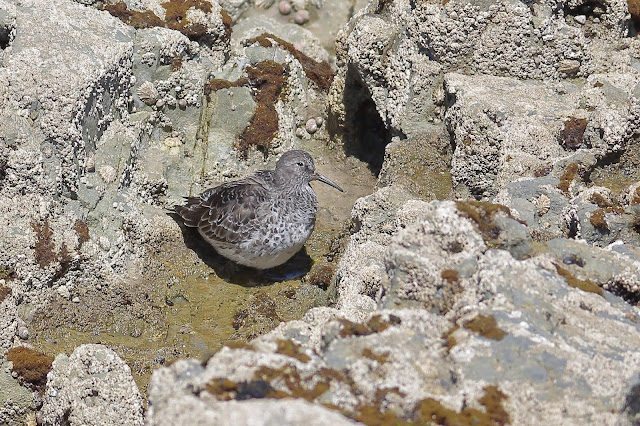


















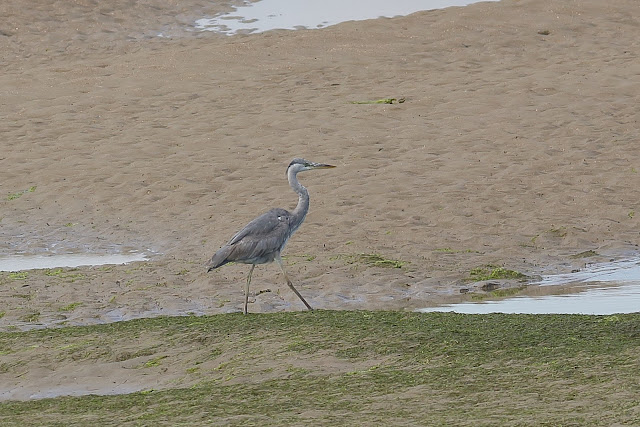









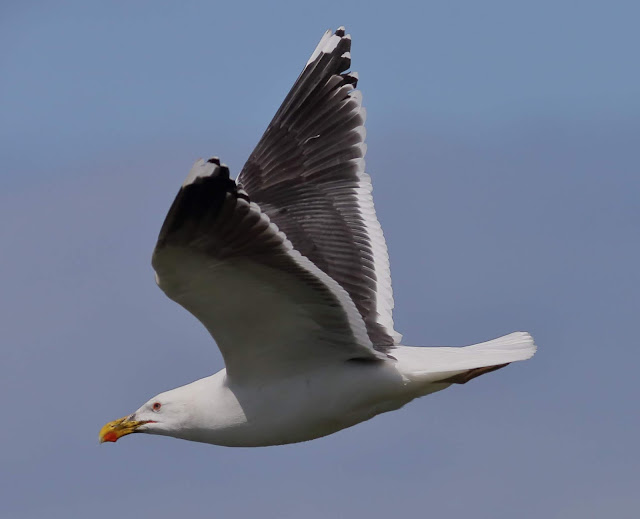







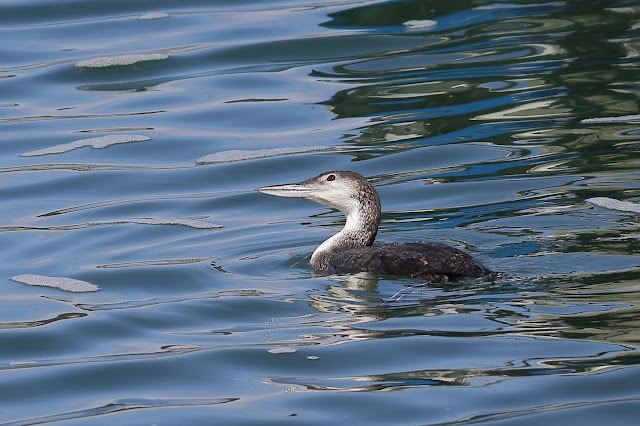











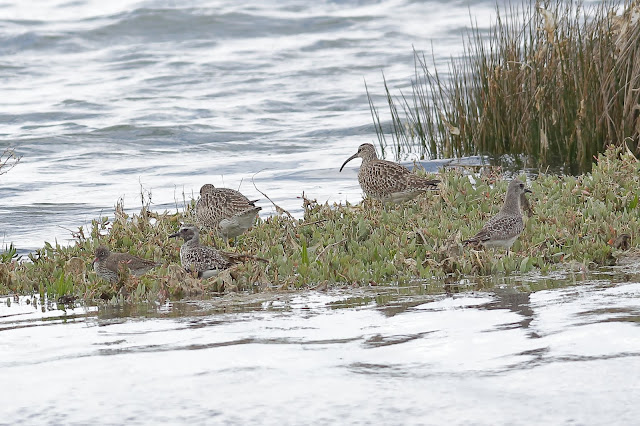










































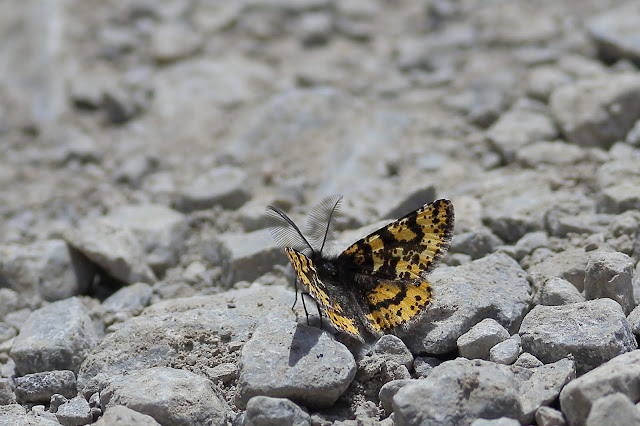

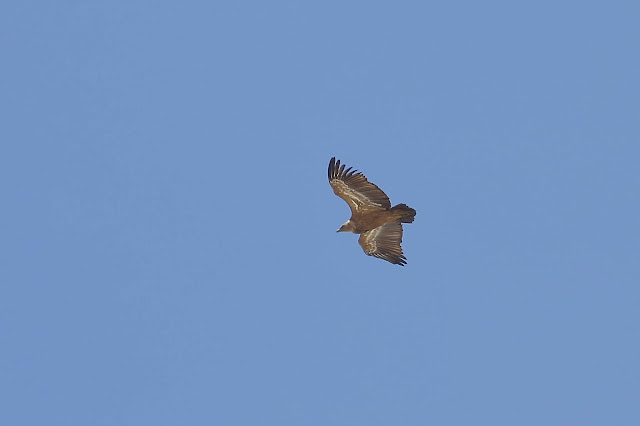



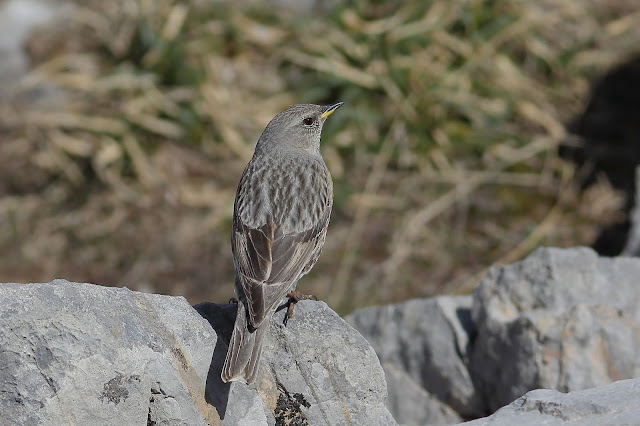







No hay comentarios:
Publicar un comentario